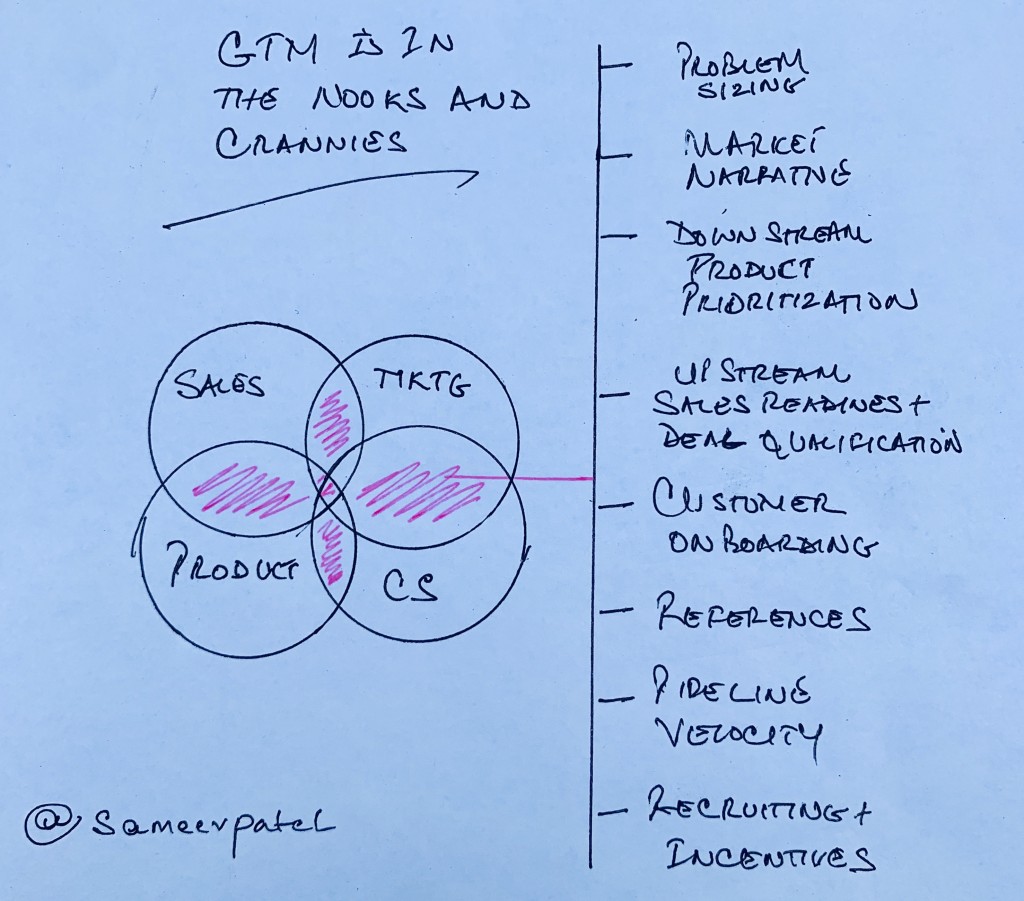What really is “Go-to-Market”?

The single most bastardized, watered-down term in the business of enterprise tech is “Go-to-Market”. Go-to-Market (GTM) gets bandied about as the cure-all to everything from missing 2 sequential quarters to losing critical deals to a single competitor, to seeing a tepid uptick in demand, to my least favorite – a one-time effort to coordinate activities when launching a new product.
If you really have a go-to-market problem, it is a systemic issue that spans across multiple functions in the organization, many of which aren’t even directly market-facing.
The definition of GTM is actually super simple. Build a moat with your market narrative and then maniacally focus on constructing and closing a pipeline via direct and indirect channels as quickly and as efficiently as possible.
If you truly have a GTM problem, the answer lies not just in a high falutin PowerPoint deck but rather, deep in the nooks and crannies of your operating machinery. All too often, GTM heroics happen in the design when it should be all about the execution.
And this is without exception, the job of the operator – the CEO, the President/COO, the GM, and the board – to define and orchestrate at a structural level.
Here is a quick illustration of a subset of root causes of your go-to-market problem:

Not a single one of these chokepoints can be addressed by tweaking or rebuilding any single silo. Successful GTM is a function of how you design and obsessively communicate the market proposition to the whole company and to the market, and subsequently, how you hire and orchestrate collaboration amongst different functions to move really really accurately and really really fast to get many customers on board as possible.
Take something as seemingly straight forward and tactical as securing references – a critical proof point that your GTM is working. A GTM focused reference is NOT just securing a polished customer success story. GTM focused references have teeth. They are a manicured depiction of the veracity of the problem and the sophistication of the solution that directly speaks not just to the awesome sauce in your product but to the market narrative that you are convinced is a story that 200 very qualified target customers already understand and are looking to solve for, today. That takes maniacal collaboration between marketing, product and customer success to influence the types of outcome that speaks to exactly the right subset of capabilities you are trying to highlight. This is GTM.
Or take a fall sense of security that early product-market fit will deliver the Market-Message fit (whole post there) that’s needed to drive up pitch rates. You may have excellent product market fit but that will not drive up pitch rates and lead to a successful GTM. Again, a problem to be first tackled not by marketing or sales, but by product teams to ensure that the product itself drives sales velocity. This is GTM.
Or take development priorities. At least at a growing business unit or at a growth-stage start up, you’re making product roadmap tradeoffs everyday between features that drive growth vs those that drive NPS, especially during wartime. Your GTM is severely impacted in a positive or negative way when you make a choice to have your sales leader sit it out for a quarter to build features that might not immedicably attract new customers but will lower churn, or drive references that will help sales 2 quarters out. This takes mad amounts of discipline, trust and sisterhood between the head of Sales and CS, with the backing of product. This is GTM.
You get my drift.
Yet, as leadership teams or even boards, we naturally go for the sales or marketing jugular when we miss a quarter or two.
At our business within SuccessFactors/ SAP, we drew revenue to $70 million from almost nothing in 4 years by shifting the market narrative on what collaboration means, and then reworking the entire product strategy, sales training, content marketing strategy, the charter for CS and reference strategy, to back the truck into that narrative. At Kahuna, our strategy was to ruthlessly narrow the market scope to just consumer marketplace retention marketing. But our GTM plan was to massively expand the product scope to become the only provider that offered both sell-side and buy-side marketing and analytics, resulting in a pipeline growth of 1900%. This is GTM.
So, the next time you miss a quarter, or the lead volume falls off a cliff, use this framework to truly work out where the leak is. Or if it’s all working well, still use it to really understand why it’s working, so you can double down and move even faster.
This at least gets you on the path to figuring out a fantastic go-to-market, and with brutal honesty.
(Comments rolling in on LinkedIn.)